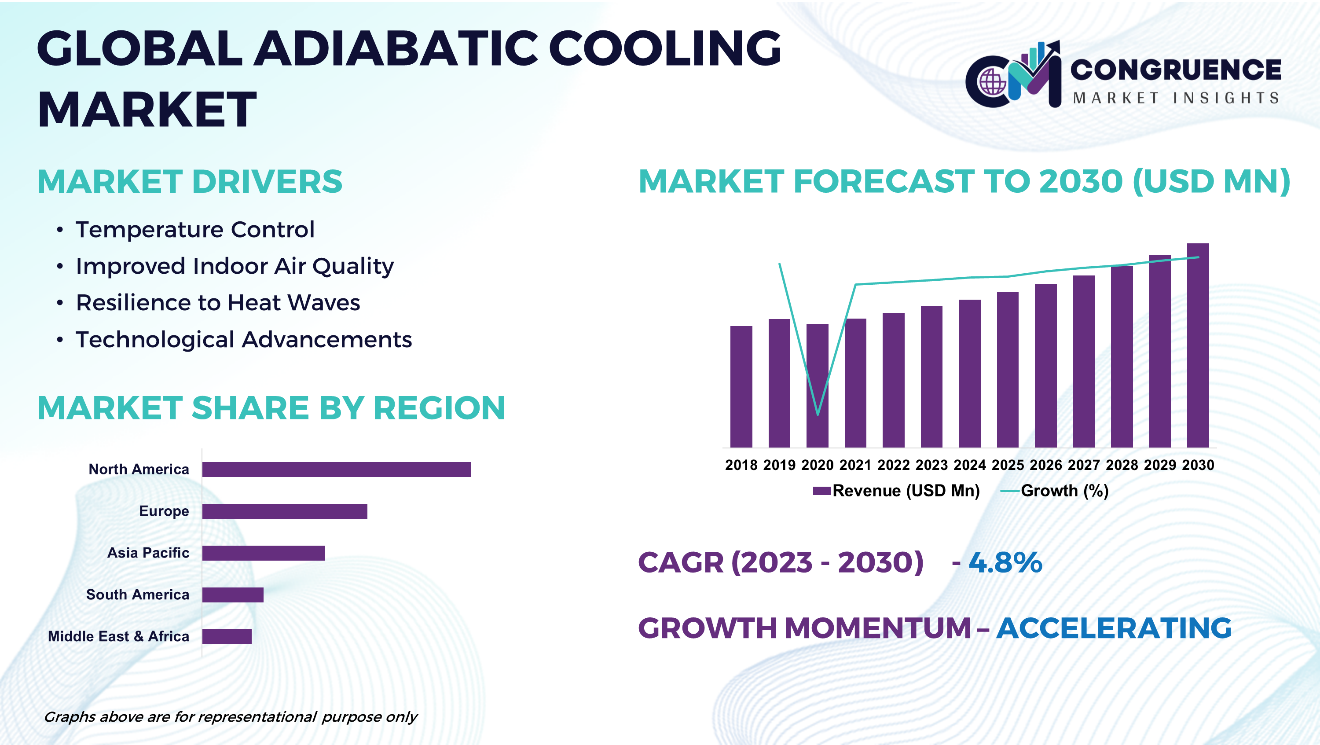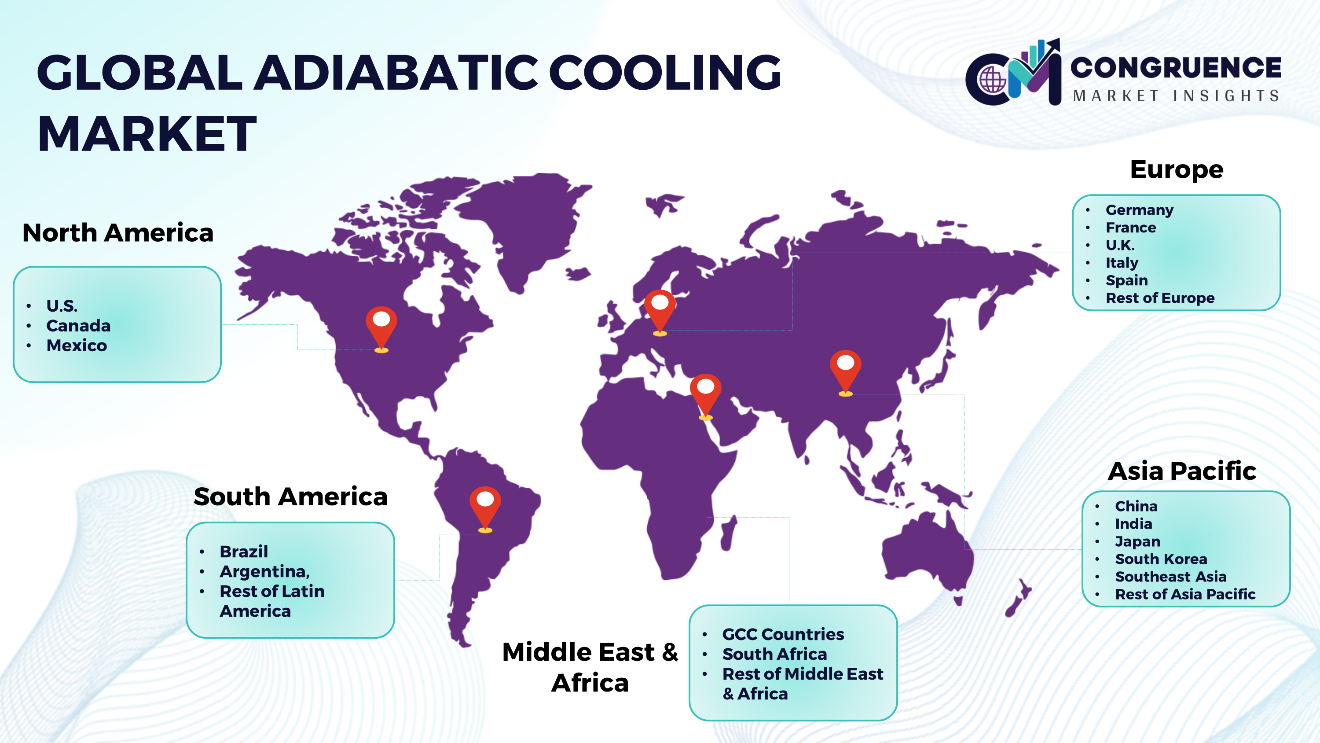Reports
The Global Adiabatic Cooling Market is expected to expand at a CAGR of 4.8% between 2023 and 2030, driven by the increasing need for improved indoor air quality and growing demand from temperature control applications.
Adiabatic cooling, a method rooted in the principles of thermodynamics, presents a compelling solution for efficient temperature regulation without reliance on external heat exchange mechanisms. This technology capitalizes on water evaporation to effectively reduce ambient air temperatures, rendering it well-suited for diverse applications. Continuous advancements in materials, notably the utilization of cutting-edge polymers and coatings, serve to augment both the longevity and effectiveness of adiabatic cooling systems. Integral components include evaporative pads, water distribution networks, and high-performance fans. Despite the presence of conventional HVAC alternatives, the burgeoning demand for adiabatic cooling solutions within data centers, industrial facilities, and commercial structures underscores a promising trajectory within the market landscape, signaling prospects for continued expansion.

Adiabatic Cooling Market Major Driving Forces
Temperature Control: The precise temperature control capabilities of adiabatic cooling systems make them well-suited for environments where maintaining stable temperatures is critical. This includes data centers, laboratories, clean rooms, and manufacturing facilities, where even slight fluctuations in temperature can have significant consequences for operations and equipment.
Improved Indoor Air Quality: Beyond temperature regulation, adiabatic cooling systems contribute to improved indoor air quality by humidifying and filtering incoming air. This helps remove airborne contaminants, allergens, and pollutants, creating a healthier and more comfortable indoor environment for occupants.
Resilience to Heat Waves: With the increasing frequency and intensity of heat waves driven by climate change, adiabatic cooling provides a reliable solution for maintaining comfortable temperatures even during extreme heat events. This resilience ensures business continuity and protects critical infrastructure from heat-related damage.
Technological Advancements: Ongoing advancements in materials, controls, and system design continuously enhance the efficiency, reliability, and performance of adiabatic cooling systems. From innovative evaporative media to sophisticated control algorithms, these technological advancements drive the evolution of adiabatic cooling technology, further increasing its appeal and adoption.
Adiabatic Cooling Market Key Opportunities
Technological Innovation: As technology continues to advance, there are opportunities for innovation in adiabatic cooling systems. This includes advancements in materials, such as more efficient evaporative pads and coatings, as well as improvements in system design and control mechanisms. Companies that invest in research and development to drive technological innovation in adiabatic cooling stand to gain a competitive advantage in the market.
Integration with Renewable Energy: Adiabatic cooling systems can be integrated with renewable energy sources such as solar power, further enhancing their sustainability and reducing reliance on grid electricity. This presents opportunities for businesses to offer integrated solutions that combine adiabatic cooling with renewable energy generation, meeting the increasing demand for clean energy solutions.
Adiabatic Cooling Market Key Trends
· Growing adoption of adiabatic cooling systems across various industries due to their energy efficiency and environmental sustainability.
· Continuous innovations in materials, controls, and system design to enhance the efficiency and effectiveness of adiabatic cooling solutions.
· Increasing integration of adiabatic cooling systems with renewable energy sources such as solar power to further enhance sustainability and reduce carbon footprint.
· Demand for customizable and scalable adiabatic cooling solutions tailored to the specific needs and requirements of different industries and applications.
· Emergence of hybrid cooling systems combining adiabatic cooling with other cooling technologies for optimal performance and energy efficiency.
· Adoption of smart controls and automation technologies to optimize the operation of adiabatic cooling systems and improve energy management.

Market Competition Landscape
Within the realm of adiabatic cooling, a multifaceted competitive landscape emerges, comprising a spectrum of entities delivering tailored solutions across diverse industries. Paramount to this competition are factors such as technological progression, energy conservation, ecological sustainability, and fiscal prudence. As the sector evolves, enterprises vie for prominence by means of distinctiveness strategies, including product innovation, strategic alliances, and strategic market positioning, to leverage the burgeoning demand for energy-efficient cooling solutions.
Key players in the global Adiabatic Cooling market implement various organic and inorganic strategies to strengthen and improve their market positioning. Prominent players in the market include:
· Güntner GmbH & Co. KG
· Trane
· ICS Cool Energy Limited
· Condair Group
· Oxycom
· Carrier
· Merlin Technology GmbH
· Seeley International
· Colt Internationa
· LENNOX
· Delta Cooling Towers, Inc.
· ALFA LAVAL
· SPX Cooling Tech, LLC
· Portacool Evaporative Coolers
· Thermax Limited
· EVAPCO, Inc.
· Bonaire Heating & Cooling
· FRIGEL FIRENZE S.p.A.
· Munters
· ZIEHL-ABEGG SE
· Klingenburg USA, LLC
· Paharpur Cooling Towers Ltd.
|
Report Attribute/Metric |
Details |
|
Base Year |
2022 |
|
Forecast Period |
2023 – 2030 |
|
Historical Data |
2018 to 2022 |
|
Forecast Unit |
Value (US$ Mn) |
|
Key Report Deliverable |
Revenue Forecast, Growth Trends, Market Dynamics, Segmental Overview, Regional and Country-wise Analysis, Competition Landscape |
|
Segments Covered |
· By Type (Dry Adiabatic Cooling, and Evaporative Adiabatic Cooling) · By Application (Air Conditioning, Industrial Cooling, Data Center Cooling, and Refrigeration) · By End-User (Industrial, Commercial, and Residential) |
|
Geographies Covered |
North America: U.S., Canada and Mexico Europe: Germany, France, U.K., Italy, Spain, and Rest of Europe Asia Pacific: China, India, Japan, South Korea, Southeast Asia, and Rest of Asia Pacific South America: Brazil, Argentina, and Rest of Latin America Middle East & Africa: GCC Countries, South Africa, and Rest of Middle East & Africa |
|
Key Players Analyzed |
Güntner GmbH & Co. KG, Trane, ICS Cool Energy Limited, Condair Group, Oxycom, Carrier, Merlin Technology GmbH, Seeley International, Colt International, LENNOX, Delta Cooling Towers, Inc., ALFA LAVAL, SPX Cooling Tech, LLC, Portacool Evaporative Coolers, Thermax Limited, EVAPCO, Inc., Bonaire Heating & Cooling, FRIGEL FIRENZE S.p.A., Munters, ZIEHL-ABEGG SE, Klingenburg USA, LLC, and Paharpur Cooling Towers Ltd. |
|
Customization & Pricing |
Available on Request (10% Customization is Free) |
